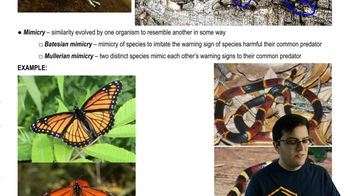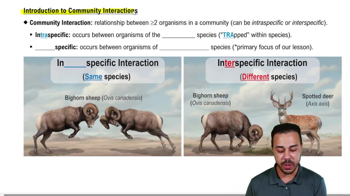Table of contents
- 1. Introduction to Biology2h 42m
- 2. Chemistry3h 40m
- 3. Water1h 26m
- 4. Biomolecules2h 23m
- 5. Cell Components2h 26m
- 6. The Membrane2h 31m
- 7. Energy and Metabolism2h 0m
- 8. Respiration2h 40m
- 9. Photosynthesis2h 49m
- 10. Cell Signaling59m
- 11. Cell Division2h 47m
- 12. Meiosis2h 0m
- 13. Mendelian Genetics4h 44m
- Introduction to Mendel's Experiments7m
- Genotype vs. Phenotype17m
- Punnett Squares13m
- Mendel's Experiments26m
- Mendel's Laws18m
- Monohybrid Crosses19m
- Test Crosses14m
- Dihybrid Crosses20m
- Punnett Square Probability26m
- Incomplete Dominance vs. Codominance20m
- Epistasis7m
- Non-Mendelian Genetics12m
- Pedigrees6m
- Autosomal Inheritance21m
- Sex-Linked Inheritance43m
- X-Inactivation9m
- 14. DNA Synthesis2h 27m
- 15. Gene Expression3h 20m
- 16. Regulation of Expression3h 31m
- Introduction to Regulation of Gene Expression13m
- Prokaryotic Gene Regulation via Operons27m
- The Lac Operon21m
- Glucose's Impact on Lac Operon25m
- The Trp Operon20m
- Review of the Lac Operon & Trp Operon11m
- Introduction to Eukaryotic Gene Regulation9m
- Eukaryotic Chromatin Modifications16m
- Eukaryotic Transcriptional Control22m
- Eukaryotic Post-Transcriptional Regulation28m
- Eukaryotic Post-Translational Regulation13m
- 17. Viruses37m
- 18. Biotechnology2h 58m
- 19. Genomics17m
- 20. Development1h 5m
- 21. Evolution3h 1m
- 22. Evolution of Populations3h 52m
- 23. Speciation1h 37m
- 24. History of Life on Earth2h 6m
- 25. Phylogeny2h 31m
- 26. Prokaryotes4h 59m
- 27. Protists1h 12m
- 28. Plants1h 22m
- 29. Fungi36m
- 30. Overview of Animals34m
- 31. Invertebrates1h 2m
- 32. Vertebrates50m
- 33. Plant Anatomy1h 3m
- 34. Vascular Plant Transport1h 2m
- 35. Soil37m
- 36. Plant Reproduction47m
- 37. Plant Sensation and Response1h 9m
- 38. Animal Form and Function1h 19m
- 39. Digestive System1h 10m
- 40. Circulatory System1h 57m
- 41. Immune System1h 12m
- 42. Osmoregulation and Excretion50m
- 43. Endocrine System1h 4m
- 44. Animal Reproduction1h 2m
- 45. Nervous System1h 55m
- 46. Sensory Systems46m
- 47. Muscle Systems23m
- 48. Ecology3h 11m
- Introduction to Ecology20m
- Biogeography14m
- Earth's Climate Patterns50m
- Introduction to Terrestrial Biomes10m
- Terrestrial Biomes: Near Equator13m
- Terrestrial Biomes: Temperate Regions10m
- Terrestrial Biomes: Northern Regions15m
- Introduction to Aquatic Biomes27m
- Freshwater Aquatic Biomes14m
- Marine Aquatic Biomes13m
- 49. Animal Behavior28m
- 50. Population Ecology3h 41m
- Introduction to Population Ecology28m
- Population Sampling Methods23m
- Life History12m
- Population Demography17m
- Factors Limiting Population Growth14m
- Introduction to Population Growth Models22m
- Linear Population Growth6m
- Exponential Population Growth29m
- Logistic Population Growth32m
- r/K Selection10m
- The Human Population22m
- 51. Community Ecology2h 46m
- Introduction to Community Ecology2m
- Introduction to Community Interactions9m
- Community Interactions: Competition (-/-)38m
- Community Interactions: Exploitation (+/-)23m
- Community Interactions: Mutualism (+/+) & Commensalism (+/0)9m
- Community Structure35m
- Community Dynamics26m
- Geographic Impact on Communities21m
- 52. Ecosystems2h 36m
- 53. Conservation Biology24m
51. Community Ecology
Introduction to Community Interactions
Problem 13c`
Textbook Question
Lyme disease is caused by infections of the bacterium Borrelia burgdorferi (stained blue in the inset, among red blood cells), which is transferred to humans via blood-sucking bites from the tick Ixodes scapularis. Lyme disease can cause flu-like symptoms in the short term and more serious illnesses in the long term if not treated.
Why is Lyme disease on the rise in eastern North America?
Deer are hosts of ticks but are not reservoirs of B. burgdorferi—their immune systems detect and kill the bacterium. But a tick with a prior bacterial infection can consume a blood meal from a deer and then bite and infect a human. The fitness effects of a deer on B. burgdorferi can be summarized as:
a. + because the deer supplies the bacterium with food.
b. − because the deer kills the bacteria in its blood.
c. + because the deer feeds and disperses the tick that can then infect a human with the bacterium.
d. − or + depending on whether the deer is the tick's last host.
 Verified step by step guidance
Verified step by step guidance1
Step 1: Understand the relationship between the deer, the tick, and the bacterium Borrelia burgdorferi. The deer serves as a host for the tick, providing it with a blood meal, but the deer's immune system kills the bacterium if it enters the deer's bloodstream.
Step 2: Analyze the role of the deer in the life cycle of the tick. The deer provides food for the tick, allowing it to survive and reproduce. This indirectly benefits the bacterium because the tick can later infect a human with Borrelia burgdorferi.
Step 3: Consider the fitness effects of the deer on Borrelia burgdorferi. While the deer kills the bacterium in its own blood, it also supports the tick population, which can carry and transmit the bacterium to humans.
Step 4: Evaluate the options provided in the question. Option (a) suggests a positive effect because the deer supplies food, but this is not directly true for the bacterium. Option (b) suggests a negative effect because the deer kills the bacterium, which is partially true. Option (c) suggests a positive effect because the deer supports the tick, which can spread the bacterium, and this aligns with the indirect benefit to the bacterium. Option (d) suggests variability based on the deer's role as the tick's last host, which is not directly relevant to the bacterium's fitness.
Step 5: Conclude that the most accurate answer is (c), as the deer indirectly benefits Borrelia burgdorferi by feeding and dispersing the tick, which can then infect humans with the bacterium.
 Verified video answer for a similar problem:
Verified video answer for a similar problem:This video solution was recommended by our tutors as helpful for the problem above
Video duration:
1mPlay a video:
Was this helpful?
Key Concepts
Here are the essential concepts you must grasp in order to answer the question correctly.
Lyme Disease Pathogenesis
Lyme disease is an infectious disease caused by the bacterium Borrelia burgdorferi, which is transmitted to humans through the bite of infected ticks, primarily Ixodes scapularis. Understanding the life cycle of the tick and the role of the bacterium in causing disease is crucial for comprehending how Lyme disease spreads and the symptoms it can cause, ranging from flu-like symptoms to more severe long-term health issues.
Recommended video:
Guided course

Cardiovascular Disease
Tick Ecology and Host Interaction
Ticks are ectoparasites that require a blood meal from a host to develop and reproduce. In the case of Lyme disease, deer serve as hosts for ticks but do not harbor the bacterium, as their immune systems eliminate it. This interaction highlights the complex dynamics between ticks, their hosts, and the pathogens they carry, which is essential for understanding the epidemiology of Lyme disease.
Recommended video:
Guided course

Positive Interactions
Fitness Effects in Ecology
In ecological terms, fitness effects refer to the impact of one species on another in terms of survival and reproduction. In the context of Lyme disease, the fitness effects of deer on Borrelia burgdorferi can be both positive and negative, depending on whether the deer serves merely as a food source for ticks or if it also contributes to the transmission of the bacterium to humans. This dual role is critical for understanding the rising incidence of Lyme disease in certain regions.
Recommended video:
Guided course

Ecology

 1:57m
1:57mWatch next
Master Introduction to Community Interactions with a bite sized video explanation from Jason
Start learningRelated Videos
Related Practice


















































